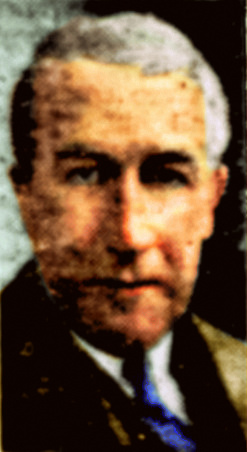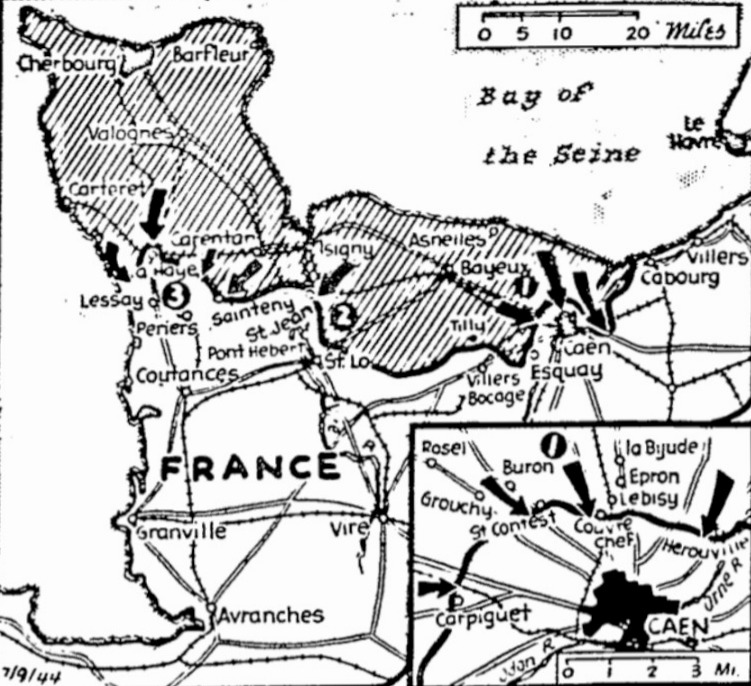Völkischer Beobachter (July 9, 1944)
SS-pk. Verwildert und sturmzerzaust liegt das alte normannische Schloss zwischen Park und See. Der uralte Wehrturm ragt steil in die stumme Nacht empor. Er wächst mit seinen kantigen Quadern wie ein Sinnbild des Unvergänglichen zur doppelten Höhe des angebauten Schlosses hinauf.
Von hier oben gleitet der Blick weit über das normannische Flachland hinweg; über das unendliche Netz der- Heckengevierte und Parkwiesen eilt er zu einem flachen Höhenzug, der sich im Osten im Halbkreis um den Schauplatz lagert, in welchem das turmbewehrte Schloss wie im Mittelpunkt einer riesigen Arena liegt.
Wie trügerisch ist dieser tiefe Friede, in den die Sommernacht gebettet zu sein scheint. Die beiden deutschen Posten, die in dieser Einsamkeit auf Wacht stehen und hinter der Kronenrampe des Turms eine Beobachtungsstelle eingerichtet haben, kennen die Tücken des Gegners und lassen deshalb ihre Augen keine Sekunde zur Ruhe kommen. Sie sind das Auge und das Ohr ihrer Batterie, sie sind die treuen Wächter ihrer Kameraden.
Während sich der Sternenhimmel strahlend über dem kleinen Erdenstern wölbt, wird die Stille, die eben noch ewig zu sein schien, mit einem Schlage zerrissen. Zunächst blitzt es in der Ferne an vier Punkten auf, als wolle die Erde den gestirnten Himmel mit reicherem Glanz überbieten. Dann faucht es zischend durch die Luft, das Geräusch wächst den beiden Männern als kreischende Dissonanz rasend schnell entgegen und zerbirst mit Donnerwucht unmittelbar unter ihnen. Einzelne Sprengstücke der feindlichen Granaten pochen knöchern an das Turmgemäuer, als suche der Tod einen Weg durch die dicken Quadern ins Innere zu finden.
Wenige Minuten später rauscht die nächste Salve heran. Eines der Geschosse trifft den Turm und zerbirst krachend an seiner Flanke, so daß die festen Mauern unter dem harten Schlag erbeben und die beiden Männer sich rasch zu Boden kauern. Der Turm hält dem scharfen Schlag zwar stand, doch trägt er eine schwere Wunde davon. Im Mauerwerk klafft ein breites Loch, dessen Steine im nachhallenden Getöse herabrieseln.
Viel verhängnisvoller ist es aber, daß durch den Einschlag die hölzerne Treppe im Innern des Turmes zerstört wurde.
Die beiden Männer tasten vorsichtig in die Bodenluke hinein, wo die suchenden Füße jedoch über abgründiger Leere schweben. Da der Turm auch von außen nicht besteigbar ist, sind die Männer abgeschnitten von aller Welt.
Sie geben trotz allem sofort ihre Funkmeldung über die Trefferlage und das beobachtete feindliche Mündungsfeuer an ihre Batterie durch und warten dann den Morgen ab in der Hoffnung, mit Hilfe des Schlossherrn oder der zur Ablösung anrückenden Kameraden einen Weg über die zerstörte Treppe ins Freie zu finden.
Bald darauf setzt der Feind das Artilleriefeuer in verschärftem Umfang fort. In gewohnter Materialverschwendung schüttet er Salve um Salve gegen die beiden Männer über dem Schloss. Nach einer halben Stunde steigert er seine Feuerkraft nochmals durch den Einsatz von Brandgranaten, durch die es ihm gelingt, einen abseitigen Geräteschuppen in Brand zu schießen. Der Schlossherr, ein greiser Marquis, wird mit seinem Personal durch den Flammenschein aus dem Keller gelockt, um die Zerstörung aufzuhalten. Da, als die Franzosen über das freie Gelände eilen, schlägt eine neue Salve von Granaten in den Park. Die heimtückischen Flammenzungen lecken gierig nach den Gewändern und den unbedeckten Körperteilen der Franzosen. Dann bietet sich das schauerliche Schauspiel dar, daß drei menschliche Gestalten als lebendige Fackeln durch die Nacht geistern – ein grausiges Symbol für den Verrat des Feindes.
Im ersten Morgengrauen zeigt sich die Turmtreppe in ihrem obersten Teil nur so weit zerstört, daß man mit Hilfe einer von unten herangebrachter Leiter die Lücke schließen kann.
Doch fast im gleichen Augenblick, in dem die Männer unter diesem Glücksfall aufzuatmen beginnen, rauscht ein Geschwader feindlicher Flugzeuge heran. Die Zeltbahnen gewähren den beiden Wächtern auf den Zinnen notdürftige Deckung. Obgleich die Tarnungsfarbe mit dem Turmuntergrund nicht übereinstimmen, sind die Männer besten Muts. Die Standhaftigkeit des Turmes gegen den schweren nächtlichen Beschuss bedeutet ihnen auch jetzt ein gutes Omen.
Dann aber, als sie durch die Lochringe der Zeltbahn dem Flug des Feindes folgen, erfaßt sie wirklicher Schrecken; sie sehen, Wie unmittelbar über ihnen der gesamte Pulk der Flugzeuge Fallschirmspringer aussetzt, die als weiße Federwolken am Himmel schweben und deren Landeziel nichts anderes als der Schlosspark bildet.
Es beginnt ein Kampf um Leben und Tod.
Die beiden einsamen Männer auf dem Turm wissen genau, wie gefährlich dieser im Rücken der Front landende Feind für die Kameraden in den vorderen Linien werden kann. Sie wissen aber auch, wie wenig sie allein gegen diese Übermacht auszurichten vermögen, und sie wissen, wie gefährdet ihre eigene Lage ist.
Aber sie handeln sofort. Der eine von ihnen jagt Magazin um Magazin aus seiner Maschinenpistole den Fallschirmjägern entsagen, während der andere, da durch das eigene Feuer die Turmstellung längst verraten wurde, aus mehreren Handgranaten eine geballte Ladung herstellt, und mit ihr die Holztreppe des Turmes bis in die Tiefe hinein zerstört, um dem Gegner die Angriffsmöglichkeit zu erschweren.
So kämpfen zwei Männer gegen mehr als zweihundert Gegner einen ungleichen Kampf, sie kämpfen in ihrer Einsamkeit auf hoffnungslos verlorenem Posten.
Elf feindliche Fallschirmjäger konnten bereits vor der Landung ausgeschaltet werden, etwa zwanzig weitere fallen alsbald durch Garben der Maschinenpistolen und durch Handgranaten in der näheren Umgebung des Schlosses.
Damit aber haben die beiden Männer alles getan, was sie tun konnten. Sie besitzen keinen Schuss Munition und keine Handgranaten mehr. Sie müssen zusehen, wie sich die gelandeten Feindtruppen formieren und zum Sturmangriff gegen den Turm ansetzen.
Zunächst wird ein regelrechter Spähtrupp eingesetzt, der, von Busch zu Busch vorspringend, den Schlosseingang gewinnt und dann durch das Innere des Schlosses in den Sockel des Turmes vorstößt. Von dort aus geht es die Treppe empor – allein der Angriff muß dort, wo die Treppe aufhört, kläglich abgebrochen werden.
Ein schwerer Granatwerfer wird in Stellung gebracht. Die erste Granate, die in steilem Flug die beiden Männer auf dem Turm erledigen soll, verfehlt ihr Ziel, fällt zur Erde zurück und verletzt mehrere Männer aus des Feindes eigenen Reihen.
Als damit auch dieses Unternehmen fehlgeschlagen ist, beginnt der Feind mit der Ausräucherung der beiden Deutschen vom Innern des Turmes her.
Er legt Sprengladung um Sprengladung in die Fundamente, in immer stärkeren Explosionen wankt das Gefüge der Quader.
Schon sind aus dem Sockel an zwei Seiten die Grundsteine herausgeflogen, schon hat sich der uralte Turm ein wenig zur Seite geneigt, schon lodern die Flammen prasselnd in den Trümmern der trockenen Holztreppe auf und senden einen erstickenden Qualm, mit Pulvergasen vermischt, in die Höhe – da, als niemand mehr auch nur den geringsten Preis auf das Leben der beiden deutschen Beobachter gesetzt hätte, begeben sich diese an ihr Funkgerät und setzen mit abgemessenen Takten einen Funkspruch an ihre Batterie ab, der bei der Gegenstelle wahrhaftes Grausen verursacht und aus den Worten besteht:
Sofortiges stärkstes Zielfeuer auf eigenen Standpunkt!
Das Feuer springt bald darauf in wilden Sätzen durch die frühe Morgenluft, es schlägt hart und unerbittlich in die Reihen der Fallschirmjäger, es folgt dem Gegner in alle Deckungen, die er sucht, in alle Gräben und Hohlwege, in denen er sich verbirgt, es zerstampft den Granatwerfer zu einem korkenzieherartigen Gebilde, es stürzt sich auf die kleinsten Gruppen des ziellos umherirrenden Feindes. Nie wurde von einem Beobachtungsstand eine zielsichere Feuerleitung gegeben als von diesem Turm aus, da die einzelnen Schüsse fast um Meterbreite auf jeden einzelnen Gegner herangelenkt werden können. Weder der Beobachter noch der Funker lassen sich jetzt, da ihre Schicksalsstunde gekommen ist, durch den beizenden Brodem beirren, der durch die Luke aus dem Turminnern herausfegt, sie achten auch nicht auf die Sprengstücke, die ihnen an den Köpfen vorbeizischen, sie sehen nur die Aufgabe, den Feind mit dem von ihnen gesteuerten Granatensturm zu vernichten.
Und es gelingt ihnen in solch vollkommener Weise, daß der deutsche Stoßtrupp, der eine Stunde später durch das Gelände kommt, fast spielend den letzten Widerstand bricht, der ihnen noch aus einzelnen feindlichen Schützennestern entgegentritt.
Als es ihnen danach in mühevoller Pionierarbeit gelingt, vom Dachfirst des Schlossgebäudes aus mittels Kletterhaken und Stufeneinschlägen die Zinnenkrone des Turmes zu erklettern, erlösen sie zwei halbbetäubte, rauchgeschwärzte Männer, die dort oben im Angesicht des Todes unerschrocken Wacht hielten.
SS-Kriegsberichter Dr. RUPERT RUPP

